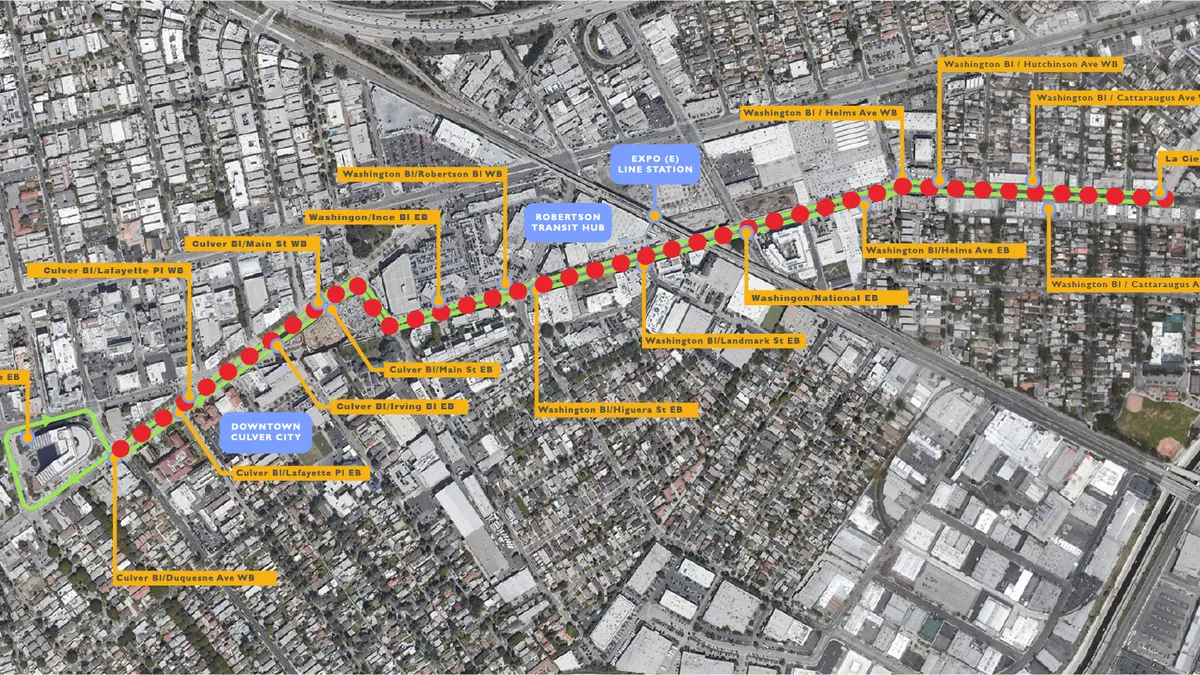Los Angeles traffic may be notorious, but it’s not because local officials haven’t tried to support alternatives to cars. The rollback of one project may offer lessons for other American cities.
In a bid to make non-car transit safer and more accessible in Culver City, California — a city of about 41,000 nestled within Los Angeles — officials launched the MOVE Culver City pilot program in November 2021. They removed a car lane and added a protected bike lane, a dedicated bus lane and some lanes shared between bikes and buses in a high-traffic downtown corridor. The pilot led to average daily increases in bus ridership, up 52% at the six-month mark; cycling, up 32% from a November 2019 baseline; and pedestrian activity, up 18% from October 2021.
Not all locals were happy with the change, though. After intense lobbying both for and against the project, the City Council voted 3-2 in late April to scale back MOVE Culver City by creating a single shared bike, bus and emergency vehicle lane and returning other lanes to cars. More than 30 organizations had signed a letter of support urging the council to make the pilot program permanent and expand it to other neighborhoods, but a community survey found that 58% of respondents opposed the pilot, mostly due to traffic concerns.
The decision was a blow to sustainable transportation advocates, but they say Culver City can provide lessons to other communities seeking to make streets safer and curb car dependency.
“It's just really sad to see [the dedicated bike lane] go away because people don't like change — because even when change is good, it's difficult for people to absorb,” said Culver City Vice Mayor Yasmine-Imani McMorrin, one of two councilmembers to vote against scaling back the project. “To me, all of this comes down to political will, and being able to explain and engage, like, ‘This is why we're doing this.’”
The program ran into several challenges, advocates said, including frustration from drivers who believed the bike and bus lanes worsened car traffic and a lack of willingness to accept that trade-off to support other transit methods. A report on the pilot found that the changes added an average of two minutes to drivers’ afternoon trips in one direction through the corridor, stating that the pilot “has not had a significant impact on peak vehicular traffic.”
Most residents viewed the pedestrian, micromobility and public transit improvements as the pilot’s strongest elements. Biking advocates said they would’ve liked to see more public communication to explain the infrastructure changes, as well as tweaks based on community feedback to improve traffic flow.
“Even those of us who wanted a yes vote to keep the project had a list of things that we thought would have improved it,” such as clearer signal timing, signage and delivery logistics for local businesses and restaurants, said Mary Daval, co-chair of Bike Culver City.
Genevieve Giuliano, a professor at the University of Southern California who studies transportation policy and travel behavior, said local officials shouldn’t rely too much on planning-stage community surveys and engagement for safe streets projects, given people don’t always know how they’ll feel about infrastructure changes until they’re actually in place.
One deciding factor for success is people’s tolerance for inconvenience, Giuliano said: Local leaders should be strategic about where they start implementing changes first. They could, for example, focus on high-density areas where residents are already dependent on public transit, biking or walking.
“You really have to think about your system: Where could you do this to add to the network in a way that makes sense?” Giuliano said. “I don't think anybody would object to [changes on] a minor street. … If you can manage this and not create a whole lot of backlash, then you're going to be successful.”
In Culver City, Daval and other advocates are weighing their options while they wait for the bike lane to be removed. While Daval said she’s concerned that the rollback of MOVE Culver City could make the state and federal governments hesitant to fund similar projects in the future, local advocates will continue pushing for more transit-friendly neighborhoods.
“We're not at all giving up,” Daval said. “We are not going to ignore other parts of the city.”
City staffers, meanwhile, are moving ahead with a second phase of the MOVE Culver City pilot on another street.
“These are policy choices,” McMorrin said. “We can have more complete streets, we can incentivize transit [and invest in] things that will actually materially impact people's day-to-day.”


















